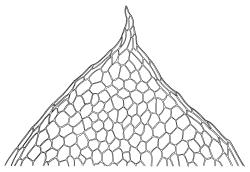Elements in the following generic description are taken from Buck (1998).
Plants small to medium-sized, soft, forming whitish- , bluish-, or yellow-green (seldom brown) glossy or dull mats. Stems creeping, irregularly branched, lacking a central strand, with sparse, smooth rhizoids. Shoots complanate. Leaves in 5–8 ranks, usually crisped when dry, asymmetric, those in dorsal and ventral ranks shorter than those in lateral ranks, broadly ovate or ± oblong, rarely lanceolate, abruptly narrowed to an acute, slenderly acuminate or cuspidate apex, bordered, toothed or entire. Upper laminal cells smooth, thin- or occasionally firm-walled, usually ± lax, hexagonal or oblong-hexagonal, becoming somewhat larger towards base; marginal cells elongate in one to several rows to form a distinct border; alar cells not differentiated. Costae double, slender or strong, extending more than half-way up leaf. Asexual propagulae lacking.
Sexuality various. Perichaetia with small, ovate or lanceolate, acuminate leaves. Setae lateral, erect, smooth, red-brown. Capsules inclined to horizontal, oblong-cylindric, with a short neck, constricted below the mouth when dry; exothecial cells not or weakly collenchymatous; annulus of a single row of cells; operculum long-rostrate from a conic base. Peristome double; exostome teeth purple or red-brown, linear-lanceolate, strongly furrowed, cross-striate below, papillose above, bordered, with lamellae that project laterally as trabeculae; endostome orange, papillose, with a high basal membrane with segments well-developed, nearly as long as the teeth, keeled and perforate; cilia absent. Calyptra mitrate-rostrate, scarcely longer than the operculum, naked, fringed at base. Spores small.
A large genus of up to 100 species distributed in tropical regions, mostly in the Neotropics. Cyclodictyon is anomalous in the family by having bordered leaves. Only one species occurs in the N.Z. Botanical Region.
| Category | Number |
|---|---|
| Indigenous (Non-endemic) | 1 |
| Total | 1 |




